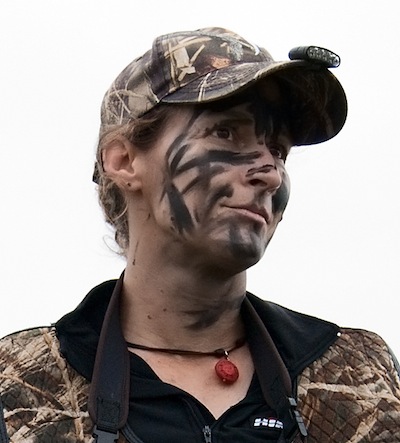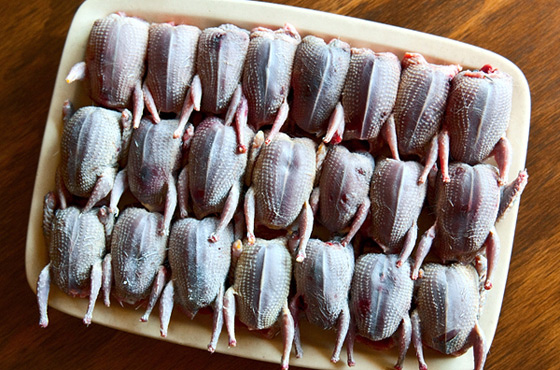Ten years ago, I never would have guessed that I’d become a hunter. I always assumed that I’d eventually raise animals for food, because that’s what my family did when I was a kid, and I knew that doing so produced better meat, and better lives for the animals. But I thought hunting was a bit creepy. I mean, killing animals for fun? Besides, guns scared me.
Then my boyfriend, Hank Shaw, started hunting, and from the very start, he invited me to join him. I was baffled. I mean, I was fine with him hunting because he was hunting for food, not for kicks, but I didn’t understand the logic of spending hours and hours in the field to get a couple ducks or rabbits when we could raise them in the back yard much more easily.
I remember asking him once, after he’d discovered he’d pulled rabbits he’d shot out of poison oak and was paying the price (he was from the East Coast and had never seen poison oak), “Wouldn’t it be easier to raise them in the backyard?” He said, “It’s not the same.” I didn’t get it.
What finally motivated me to join him was ducks. Wild ducks taste amazing, and you can’t get anything like them in any store, or even from your backyard. I decided that if I could eat them, I could damn well take responsibility for hunting them too. So I dove in.
What are your priorities when it comes to finding your own food?
I didn’t set out to design my hunting this way, but this is how it has worked out: What I love to eat the most, I love to hunt the most. I won’t hunt anything that I won’t eat.
But the force that motivates me to go out, and to endure sometimes harsh conditions, and the very real possibility of failure, is a bit more mysterious, and not driven directly by food. I love hunting. It is absolutely joyful. With rare exceptions -- like having a migraine, or shooting really, really badly -- I am blissful when I’m in the field.
Creepy, eh? How can I find killing to be joyful? The answer is, I don’t. Killing is unpleasant, at best, and can be really horrible if you do a bad job of it and the animal doesn’t die quickly. Yes, I’m excited when I have been successful, because a lot of planning and practice goes into that success. But I almost always put myself in the animal’s shoes as it dies, and it’s nauseating.
I have spent a lot of time trying to figure out why I love it so much, given the painful reality of inflicting death, and I have two explanations. One is that there is something fulfilling about doing what it is we’re supposed to do. Civilization has turned us into a species of dependents; very few of us know how to feed ourselves in a natural environment. Amazingly, we accept this as normal, when it’s actually insane. While civilization has given us lots of comforts and conveniences, it has also inflicted on us -- and the planet -- a lot of disease, physical and mental. Returning to how we’re designed to live is a brief reprieve from that insanity, even if we can’t truly escape civilization.
Reason No. 2 is the biological origin of the mental state I’ve described above: Love for hunting is a result of natural selection. In the past, those who loved hunting were more likely to bring home lots of meat, which led to healthier families, and a higher survival rate of offspring than for those who didn’t love hunting. Therefore, nature selected for those who love hunting. Ten thousand years of a more sedentary agricultural lifestyle can’t trump a million years of our genetic history.
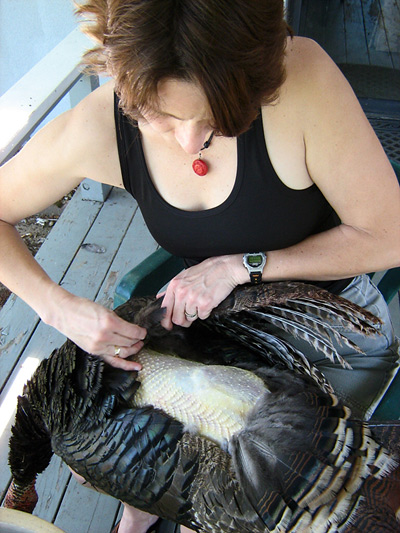
Plucking Wild Turkey. Photo courtesy of Holly A. Heyser
What's your favorite creature to hunt, and why?
Ducks, ducks, ducks, ducks, ducks. They taste the best. We hunt primarily in the Sacramento Valley, where the ducks get fat all winter on the rice that remains in harvested fields, and fat is flavor. My favorite way to cook them is taking a dressed whole bird, salting it, browning it in duck fat, roasting it until the meat in the breast reaches 135 degrees, tenting it in foil for five minutes, then digging in. It’s eyes-rolling-back-in-your-head good.
They’re also fun to hunt because they’re challenging. They have a thousand ways to thwart me, which makes me laugh at myself. Ruddy ducks are some of the best at that. For duck hunting, I hide in clumps of cattails and lure ducks in range with decoys and duck calls. We’ll see ruddies barreling in from a quarter mile away, and they’re so fast that they’re almost impossible to shoot. They’ll fly low over the water, then lift just a little bit to zoom over us, often close enough for us to grab them. I’ve watched ruddies fly just a foot over my hunting partner’s head, or even between my hunting partner and me. I’m pretty sure they have a sense of humor.
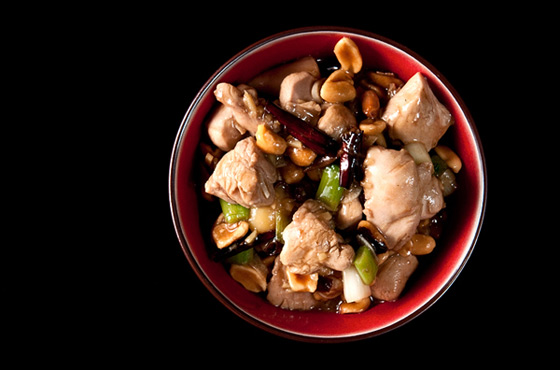
Kung Pao Pheasant. Photo courtesy of Holly A. Heyser
Do you think your diet has improved since you started eating wild game/fowl?
Absolutely! I eat a more varied diet than I used to, not sticking to the chicken-pork-beef diet of most meat eaters. We eat rabbit, hare, dove, pigeon, snipe, squirrel, turkey, duck, goose, pig, deer, bear, elk and antelope. All of those animals taste different from one another, and even within each species, there are flavor differences rooted in each animal’s particular diet. Beyond that, I eat more parts of animals, including livers, hearts and gizzards, which can bring different nutrients to the table. (Literally!)
Also, I’m not ingesting all the hormones and antibiotics that go into the meats most meat-eaters consume. I can’t say the meat we eat is totally organic, because animals we hunt definitely feast at least in part in agricultural fields where pesticides and herbicides may have been used. But I suspect the meat we eat is far less polluted than what’s available in most stores.
And here’s a fun fact: My exercise regimen has gone out the window in the past five years (related to other factors in my life, not hunting), and I’ve abandoned the hideous low-fat diet I used to follow. I eat as much fat as I want, particularly duck fat, which we render during duck season and use to flavor foods year-round. But my cholesterol tests are nothing short of amazing -- the numbers are always in the “unusually good” range.
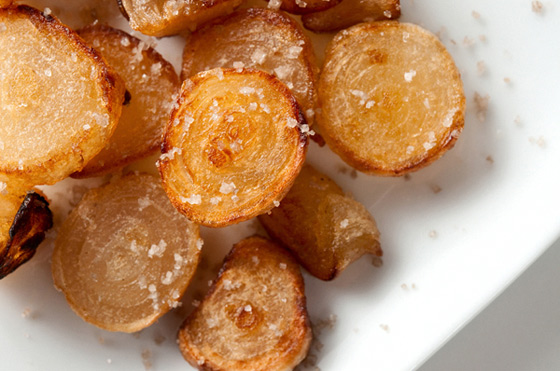
Blue Camas Bulbs. Photo courtesy of Holly A. Heyser
Why do you chronicle your experiences on your blog, NorCal Cazadora?
I started the blog on a lark --– I was looking for a platform for teaching my students a little HTML (I’m a journalism lecturer at Sacramento State), and I found Blogger so easy to use that I thought, “Hey, I can do this!”
At first I thought no one would read it. I mean, what hunter would look to a total newbie for advice or information? But I quickly found out that seasoned hunters really enjoyed reliving the experiences of a beginner through me. And people who were interested in taking up hunting – particularly women -- enjoyed having a role model who made them feel like they could do it too.
The basic story-telling on my blog very quickly evolved into a great ongoing conversation with my readers about why we hunt, and what ethical rules we should follow. I didn’t grow up hunting, so I’ve had to find my own way. It’s my readers who have helped me do that, and I am so grateful for this extended community I’ve found.
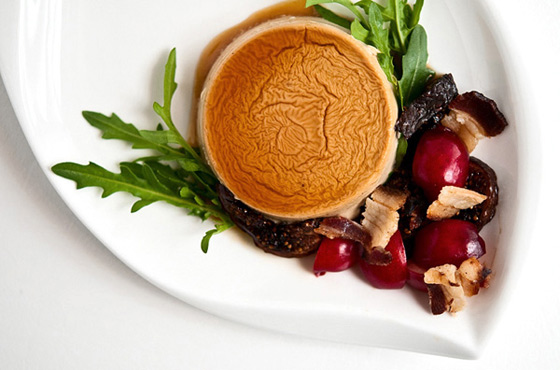
Wild Boar Liver Creme Caramel. Photo courtesy of Holly A. Heyser
What advice would you give to women who want to try hunting, but are unsure, intimidated, or any number of other feelings that might keep them from picking up a gun?
Let’s take these one at a time:
Fear of guns? I get that. But a gun is a tool, like a kitchen knife. You can cause tremendous harm with it if you’re careless, but there are rules that keep us safe with them, when we follow those rules. A huge part of learning to hunt is learning gun safety, so you can’t start hunting without learning those rules. A key one is always knowing where the muzzle of your gun is pointed, and making sure it’s not pointed at a human. I’ve had new hunters accidentally hit the trigger of their guns twice in the past few years, and the fact that their muzzle was pointed in a safe direction meant that the mishap, while disconcerting, was not harmful.
Intimidated? A lot of women worry about looking stupid shooting or hunting around more experienced people, particularly around men. For them, there are lots of programs where they can learn to shoot, take their hunter education course and even go on their first hunt in women-only groups. California Waterfowl does a ton of programs like that. I work with Cal Waterfowl on one held each September in which women do hunter ed, shooting instruction and a first hunt in one weekend -- a process that took me six weeks when I first started. It’s worth noting that Cal Waterfowl also has programs to help adult men, who can be equally intimidated, possibly even more so, because as men, they’re expected to be comfortable around firearms.
Unsure? This is the most important one. Can I kill? Can I gut an animal? Many women I meet say, “Oh, I couldn’t do that,” and I tell them they’d be very surprised about what they can do. That said, hunting isn’t for everyone. I strongly recommend that women (or men, for that matter) go along on a hunt before deciding to commit to hunting. They’re either going to hate it or they’re going to feel that electricity that I felt when I went along on a hunt -- the feeling that told me I must do this. If it’s not for you, that’s fine. You don’t have to apologize for it. There are other ways to acquire meat that’s been raised outside of the factory farms that many of us find so repugnant. And frankly, going vegetarian is an option too, if you really find the killing that upsetting.
One obstacle you don’t mention is money. Hunting isn’t cheap. Licenses, stamps and tags are expensive. Guns are expensive. Ammunition is expensive. Guides are expensive (you don’t have to hunt with them, but you’ll learn faster if you start with them). Gas is expensive, and unless you live in a place where you can step outside your back door and hunt, you’re going to have to drive to your hunting spots.
I won’t lie: The meat we eat in our house costs more than the meat we would buy at the store. It’s worth it to us because the meat is so good, and the experience adds so much to our lives. The upside is that we can take pride in the fact that the taxes and fees we pay on equipment, the hunting license fees and the public land use fees go directly into supporting habitat, not just for the animals we hunt, but for all the animals in those ecosystems. It isn’t a stretch in any way to say that the tremendous rebound we’ve seen in many wild animal populations is due to the contributions of hunters, not something achieved in spite of us. Urban and suburban land development takes habitat away; hunters give land back.
Related Video:
QUEST: Hog Wild
Video on Jul 14, 2009 by Chris Bauer from QUEST Northern California
